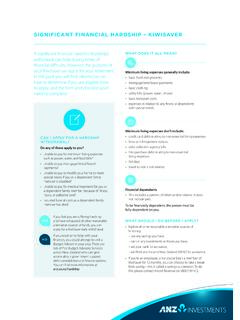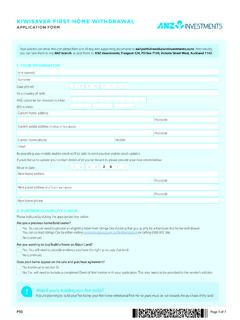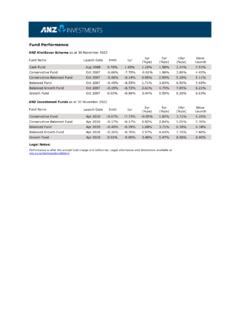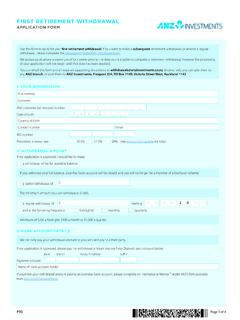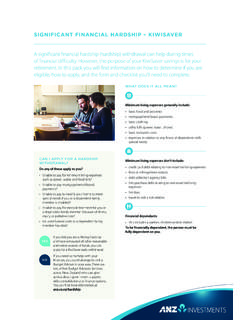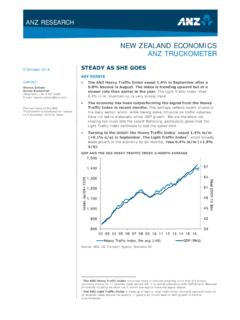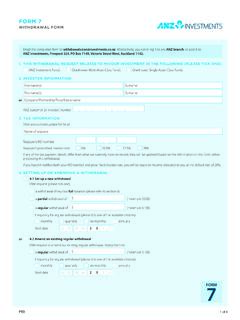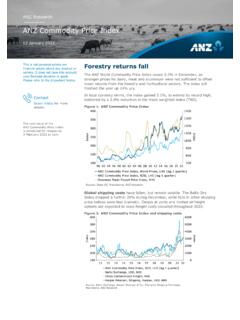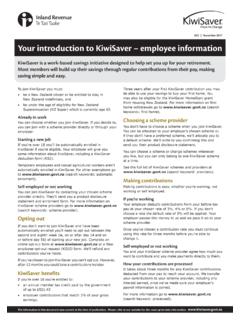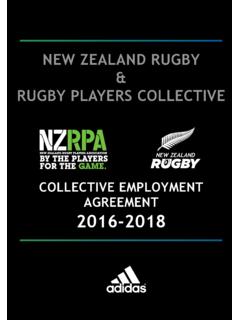Transcription of ANZ KIWISAVER SCHEME PRODUCT DISCLOSURE …
1 PRODUCT DISCLOSURE STATEMENT10 AUGUST 2018 ISSUER AND MANAGER: ANZ NEW ZEALAND INVESTMENTS LIMITEDANZ KIWISAVER SCHEMEThis PRODUCT DISCLOSURE statement replaces the PRODUCT DISCLOSURE statement dated 24 November document gives you important information about this investment to help you decide whether you want to invest. There is other useful information about this offer on ANZ New Zealand Investments Limited has prepared this document in accordance with the Financial Markets Conduct Act 2013. You can also seek advice from a financial adviser to help you make an investment is this?This is a managed investment SCHEME . Your money will be pooled with other investors money and invested in various investments. ANZ New Zealand Investments Limited (ANZ Investments, we, us and our) will invest your money and charge you a fee for its services. The returns you receive are dependent on the investment decisions of ANZ Investments and the performance of the investments. The value of those investments may go up or down.
2 The types of investments and the fees you will be charged are described in this will your money be invested in?ANZ KIWISAVER SCHEME ( SCHEME ) offers six funds. There is also a Lifetimes option, where your KIWISAVER savings are invested in one of our funds based on your age. These investment options are summarised over the page. More information about the investment target and strategy for each investment option is provided at page manages the SCHEME ?ANZ Investments is the manager of the SCHEME . See page 16 for more can you get your money out?You can begin withdrawing your KIWISAVER savings when you turn 65, provided you ve been a member of a KIWISAVER SCHEME or complying superannuation fund (if you transferred from that fund) for at least five limited circumstances, you may be able to withdraw some, or all, of your KIWISAVER savings early. See page 8 for more will your investment be taxed?The SCHEME is a portfolio investment entity (PIE). The amount of tax you pay in respect of a PIE is based on your prescribed investor rate (PIR).
3 This can be , or 28%. See section 6 of the PDS (What taxes will you pay?) on page 16 for more can you find more key information?ANZ Investments is required to publish quarterly updates for each fund. The updates show the returns, and the total fees actually charged to investors, during the previous year. The latest fund updates are available at The manager will also give you copies of those documents on KEY INFORMATION SUMMARY1 FundDescriptionInvestment objectivesAims to achieve a positive yearly return (after the fund charge and before tax) that over the long term:Growth FundInvests mainly in growth assets (equities and listed property), with a smaller exposure to income assets (cash and cash equivalents and fixed interest). The fund may also invest in alternative over inflation (allowing for a negative return years in every 20).Balanced Growth FundInvests mainly in growth assets (equities and listed property), with some exposure to income assets (cash and cash equivalents and fixed interest).
4 The fund may also invest in alternative over inflation (allowing for a negative return years in every 20).Balanced FundInvests in similar amounts of income assets (cash and cash equivalents and fixed interest) and growth assets (equities and listed property). The fund may also invest in alternative over inflation (allowing for a negative return years in every 20).Conservative Balanced FundInvests mainly in income assets (cash and cash equivalents and fixed interest), with some exposure to growth assets (equities and listed property). The fund may also invest in alternative over inflation (allowing for a negative return years in every 20).Conservative FundInvests mainly in income assets (cash and cash equivalents and fixed interest), with a smaller exposure to growth assets (equities and listed property). The fund may also invest in alternative over inflation (allowing for a negative return years in every 20).Cash FundInvests mainly in cash and cash equivalents.
5 These may include investments issued by the New Zealand Government, New Zealand-registered banks, corporations and local in line with the S&P/NZX Bank Bills 90 Day A membership fee of $2 each month ($24 each year) funds2 FundDescriptionInvestment objectivesAims to achieve a positive yearly return (after the fund charge and before tax) that over the long term:Growth FundInvests mainly in growth assets (equities and listed property), with a smaller exposure to income assets (cash and cash equivalents and fixed interest). The fund may also invest in alternative over inflation (allowing for a negative return years in every 20).Balanced Growth FundInvests mainly in growth assets (equities and listed property), with some exposure to income assets (cash and cash equivalents and fixed interest). The fund may also invest in alternative over inflation (allowing for a negative return years in every 20).Balanced FundInvests in similar amounts of income assets (cash and cash equivalents and fixed interest) and growth assets (equities and listed property).
6 The fund may also invest in alternative over inflation (allowing for a negative return years in every 20).Conservative Balanced FundInvests mainly in income assets (cash and cash equivalents and fixed interest), with some exposure to growth assets (equities and listed property). The fund may also invest in alternative over inflation (allowing for a negative return years in every 20).Conservative FundInvests mainly in income assets (cash and cash equivalents and fixed interest), with a smaller exposure to growth assets (equities and listed property). The fund may also invest in alternative over inflation (allowing for a negative return years in every 20).Cash FundInvests mainly in cash and cash equivalents. These may include investments issued by the New Zealand Government, New Zealand-registered banks, corporations and local in line with the S&P/NZX Bank Bills 90 Day A membership fee of $2 each month ($24 each year) indicatorEstimated annual fund charge(percentage of net asset value of the fund)Lifetimes option age 65+See page 13 for an explanation of the risk indicator and for information about other risks that are not included in the risk indicator.
7 To help you clarify your own attitude to risk, you can seek financial advice or work out your risk profile at Higher riskPotentially higher returns7362514 Lower riskPotentially lower returnsHigher riskPotentially higher returns7362514 Lower riskPotentially lower returnsHigher riskPotentially higher returns7362514 Lower riskPotentially lower returnsHigher riskPotentially higher returns7362514 Lower riskPotentially lower returnsHigher riskPotentially higher returns7362514 Lower riskPotentially lower returnsHigher riskPotentially higher returns7362514 Lower riskPotentially lower returns3 CONTENTS1. Key information summary12. How does this investment work?53. Description of your investment options104. What are the risks of investing?135. What are the fees?146. What taxes will you pay?167. Who is involved?168. How to complain179. Where you can find more information1810. How to apply18 Application formsAfter page 1842. HOW DOES THIS INVESTMENT WORK?How your savings are invested in a fundYour KIWISAVER savings are invested in a fund, or funds, of your choice.
8 Every time a contribution is made to your KIWISAVER account, you receive units in the fund, or funds, you re invested in. The number of units you receive depends on the price of the units at the time of the contribution. The price of a unit depends on the value of the fund. The number of units you have, when multiplied by the unit price, represents the value of your KIWISAVER savings in a fund, not including unpaid tax or tax rebates. The savings in your KIWISAVER account grow when your fund s unit price increases. This will happen when the assets that the fund invests in increase in value. Of course, your savings can also go down when the assets the funds invest in decrease in value although the aim over the long term is to achieve a positive return in most years. See page 10 for more SCHEME is a trust, registered under the Financial Markets Conduct Act 2013 as a KIWISAVER SCHEME . KIWISAVER is a long-term savings initiative, designed to help you save for your retirement. Generally, you can only gain access to your KIWISAVER savings when you re eligible for a retirement withdrawal.
9 See page 8 for more information. Your KIWISAVER account may be made up of contributions from you, your employer and the Government. These contributions are invested in a fund, or funds, of your is a fund?A fund is a pool of money made up of the KIWISAVER savings of the members invested in that fund. A fund invests in one or more asset classes, with the aim of growing the savings in your KIWISAVER account over SCHEME has six funds, each with different levels of risk and expected return. The assets of one fund are not available to be applied to meet the liabilities of any other fund. Providing you with a range of investment fund to suit youOur team does all the research and work for you (and they re very good at it).Experienced managers with a long history of strong performanceA wide variety of investments and broad aim to select assets that we believe will perform strongly over the long managementTHE BENEFITS OF OUR INVESTMENT APPROACH As your KIWISAVER savings are pooled with the savings of other members, you can benefit from:5 How do I choose a fund?
10 You decide which of the funds your KIWISAVER savings are invested in. You can choose between them by selecting: our Lifetimes option, where your KIWISAVER savings are moved through our funds based on your ageOR from our funds yourself. See page 10 for more you don t tell us your choice, and we: know your date of birth, your savings will be invested in our Lifetimes option don t know your date of birth, your savings will be invested in our Conservative Fund. If you need help choosing a fund, you can seek financial advice or work out your risk profile at the SCHEME If you re a KIWISAVER memberIf you re already a KIWISAVER member, you can transfer to the SCHEME at any time. You should compare your current SCHEME and consider any benefits you currently receive before transferring schemes . If you re not a KIWISAVER memberTo be eligible to join KIWISAVER , you must be: a New Zealand citizen or entitled to remain in New Zealand indefinitely living or normally living in New Zealand under the qualifying age for New Zealand Superannuation (currently 65 years).
